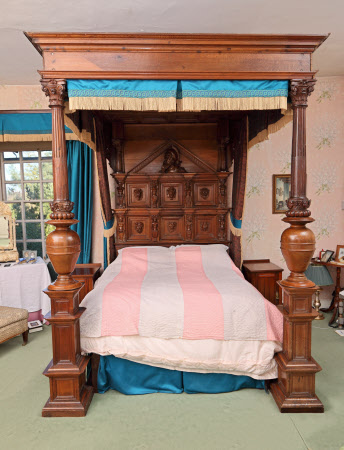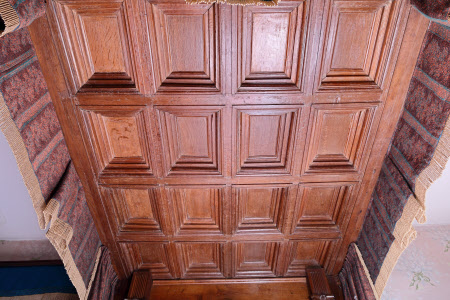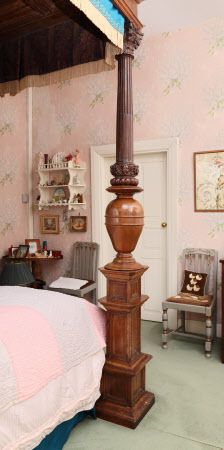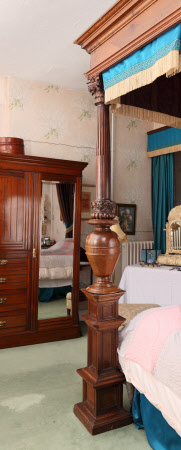Sizergh Castle's 'walnot tre bedd', circa 1570
Category
Furniture
Date
circa 1560
Materials
Walnut, Oak, Ash, Elm
Measurements
269 x 194.5 x 236 cm
Place of origin
Westmorland (England)
Order this imageCollection
Sizergh Castle, Cumbria
NT 998261
Summary
A walnut, oak, ash and elm tester bed, circa 1560, probably made in Westmorland. Topped by a tester of heavily moulded oak panels, and with moulded walnut cornice with plain friezes (probably later replacements). The extraordinary headboard of walnut panels beneath a pediment formed from dentilled and egg and dart-carved mouldings framing an applied bust, in high relief, of a bearded, armoured warrior with crested helmet looking to dexter. All above six edge-moulded panels, each framing a different applied mask, carved as satyrs, lions and grotesque faces. The panels forming two architectural registers spaced by projecting pilasters mounted with figural terms, with scrolling plinths for legs and scrolls for arms, some topped by Ionic capitals, others topped by Corinthian capitals. The pediment flanked by fluted Corinithian columns and before - probably later - backboards. The freestanding footposts topped by stop-fluted Corinthian columns turned from oak, with a collar of winged masks above a bulbous turning (in ash or elm), all on a broadening paneled pedestal of three tiers, with heavy mouldings.
Full description
This remarkable bed is probably the best example at Sizergh, although it has received relatively little attention from scholars, standing in a part of the castle which is not on show to the public. It is probably the 'walnot tre bedd' recorded as standing 'In the inar chamber in the mydle towar' in the inventory taken after Walter Strickland's death in 1569, valued at the large sum of £3. The inner chamber in the middle tower was probably what is now called the 'Queen's Room', but was then the best bedchamber, formed when William Strickland divided a much larger room to create a suite of principal rooms for guests. The overmantel in the Queen's Room is dated 1569; that to the next door great chamber (now the Dining Room) is dated 1564. Traditionally, it is the bed in the Inlaid Chamber, originally probably mostly of walnut but with later repairs and alterations in oak, which has been associated with this entry in the inventory. However, the Inlaid Chamber, for which the bed that stands there is thought to have been made, did not exist at the time the inventory was taken. The paneling and the bed are also of a different character to the woodwork undertaken in the 1560s; and probably date to the late 1570s & early 1580s, long after the inventory was made. This bed, however, with its pediment, masks and fluted columns is much more in keeping with the work undertaken at Sizergh in the 1560s. The high-relief bust to the pediment's tympanum ties it to the two overmantels in the house which share this feature, that in the Dining Room [NT 998730], which is dated 1563, and that in the Queen's Room [NT 998729], dated 1569. where it is suggested that this bed stood. The former shows a less masculine and un-helmeted figure but the latter is very similar to the one to this bed, looking upwards and to dexter, and with a similar beard. In addition, it is remarkably similar to a bed at nearby Castle Dairy, in Kendal, which is dated 1562. Both the bed and overmantels were clearly made by someone familiar with the designs of du Cerceau and Hans Vredeman de Vries (1526 - 1609). A canopy depicted in a du Cerceau etching of circa 1565 - 70 is supported on fluted columns which are encircled by a collar of almost identical winged masks as those to the posts of this bed. 'Differente pourtraicts de menuiserie', published circa 1580, shows four beds, all with distinctive triangular headboards capped by pediments. One - the etching is indistinct here - seems to show a bust to the tympanum of one. No records survive to identify the carver of this bed, nor the overmantels which it resembles, but it is traditionally thought that they were foreign craftsmen. Wells-Cole has suggested that some of the overmantels in the house may have been made by a workshop in Newcastle. (Megan Wheeler, 2016)
Provenance
Probably commissioned by Walter Strickland (1516 - 1569) and/or Alice Strickland (c. 1520 - 1588), thence by descent, and given by Henry Hornyold Strickland (1890 – 1975) with Sizergh Castle and its estates in 1950.
References
Wells-Cole 1997 Anthony Wells-Cole, Art and Decoration in Elizabethan and Jacobean England: the influence of continental prints, 1558-1625, New Haven & London 1997, p. 21 [Raine, 1853] James Raine, Wills and Inventories from the Registry of the Archdeaconry of Richmond (1853), p. 221 Goodall, 2002: Ian Goodall. “Privacy, display and over extension: Walter Strickland’s rebuilding of Sizergh.” Antiquaries Journal 82 (2002): pp.197-245. Bourne and Stuart, 1991: Susan Bourne and Susan Stuart. “Sixteenth-century furniture in the Castle Dairy, Kendal.” Regional Furniture 5 1991: pp.51-9. Goodall, 2002: Ian Goodall. “Privacy, display and over extension: Walter Strickland’s rebuilding of Sizergh.” Antiquaries Journal 82 (2002): pp.197-245.






